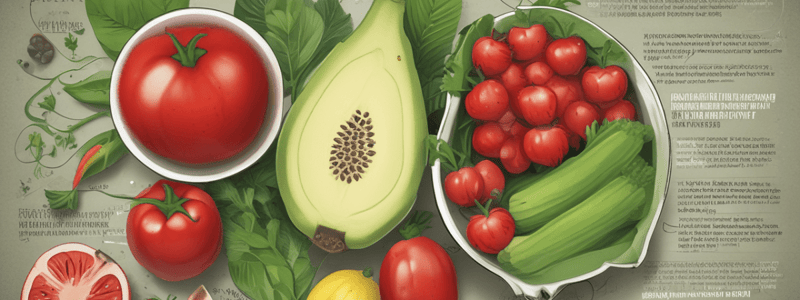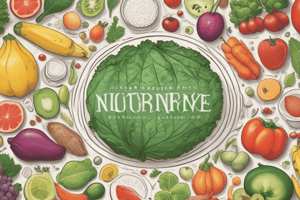Podcast
Questions and Answers
What skill do children develop when they practice using polite expressions like 'please' and 'thank you' during mealtime?
What skill do children develop when they practice using polite expressions like 'please' and 'thank you' during mealtime?
- Problem-solving skills
- Social skills (correct)
- Motor skills
- Language acquisition
What is the primary purpose of the 'My Plate' visual aid?
What is the primary purpose of the 'My Plate' visual aid?
- To promote the consumption of healthy foods
- To provide nutrition education to parents
- To provide a visual guide for meal planning (correct)
- To replace the food pyramid
How do caregivers and educators enrich vocabulary acquisition during mealtime?
How do caregivers and educators enrich vocabulary acquisition during mealtime?
- By modeling healthy eating behaviors
- By introducing new foods
- By encouraging children to make decisions during mealtime
- By using descriptive language related to sensory aspects of the meal (correct)
What is the recommended proportion of fruits and vegetables on the 'My Plate'?
What is the recommended proportion of fruits and vegetables on the 'My Plate'?
What skill do children develop when they practice handling utensils, pouring liquids, or scooping food during mealtime?
What skill do children develop when they practice handling utensils, pouring liquids, or scooping food during mealtime?
Why is it important for adults to model healthy eating behaviors during mealtime?
Why is it important for adults to model healthy eating behaviors during mealtime?
Why is it important for child care centers to educate parents about healthy food choices?
Why is it important for child care centers to educate parents about healthy food choices?
What is the broader benefit of mealtime in educational settings?
What is the broader benefit of mealtime in educational settings?
What is the primary benefit of using the 'My Plate' tool in child care centers?
What is the primary benefit of using the 'My Plate' tool in child care centers?
What is the recommended approach to serving food in child care centers?
What is the recommended approach to serving food in child care centers?
What is essential for children's social, physical, cognitive, and emotional growth?
What is essential for children's social, physical, cognitive, and emotional growth?
Why is it important to stay consistent in teaching children life skills?
Why is it important to stay consistent in teaching children life skills?
What is a benefit of allowing children to serve themselves during meal times?
What is a benefit of allowing children to serve themselves during meal times?
Why is it necessary to have extra food and serving bowls during family dining?
Why is it necessary to have extra food and serving bowls during family dining?
What is a key factor in helping children feel more confident during meal times?
What is a key factor in helping children feel more confident during meal times?
What is an important aspect of Family Style Dining Meal Time?
What is an important aspect of Family Style Dining Meal Time?
What is a challenge that teachers and caregivers may face when teaching children life skills?
What is a challenge that teachers and caregivers may face when teaching children life skills?
Flashcards are hidden until you start studying
Study Notes
USDA Dietary Guidelines for Americans
- The United States Department of Agriculture (USDA) released the seventh edition of the dietary guidelines for Americans in 2010.
- The guidelines provide evidence-based nutritional advice to promote health, reduce the risk of chronic diseases, and reduce the prevalence of overweight and obesity through improved nutrition and physical activity.
My Plate
- The USDA developed a visual aid called My Plate to replace the food pyramid.
- My Plate uses a plate setting format to show the types and amounts of recommended foods.
- The composition of My Plate includes:
- One quarter of the plate for protein sources (e.g., fish, poultry, meat)
- One quarter of the plate for starch (e.g., whole grains)
- Half of the plate for fruits and vegetables
Importance of Nutrition Education
- Child care centers should provide education on healthy food choices to parents.
- My Plate is a valuable resource for nutrition education.
- Centers can provide education sessions with parents to help them understand how to use My Plate.
Role of Meal Time in Child Development
- Meal time in child care and educational settings extends beyond just eating and can be leveraged as a multifaceted learning opportunity.
- Social skills, language acquisition, motor skills, cognitive growth, and the establishment of healthy habits can be developed during meal time.
Meal Time Learning Opportunities
- Meal time can foster social skills, such as:
- Using polite expressions (e.g., "please" and "thank you")
- Articulating needs and waiting turns
- Practicing patience and sharing space and resources with peers
- Meal time can enhance language and vocabulary development by:
- Introducing new words related to food experiences
- Using descriptive language related to sensory aspects (e.g., taste, color, texture, and smell)
- Meal time can improve fine motor skills and hand-eye coordination through:
- Handling utensils and pouring liquids
- Scooping food and using precision and control
- Meal time can encourage decision-making and problem-solving skills by:
- Offering choices and encouraging children to make decisions
- Solving problems related to eating and balancing a plate
Modeling Healthy Eating Behaviors
- Adults play a crucial role in modeling healthy eating behaviors during meal time.
- Children are likely to emulate healthy eating behaviors when they observe caregivers choosing nutritious foods and practicing portion control.
Building Self-Esteem and Independence
- Consistency is critical in having a successful family dining experience with young children.
- Providing opportunities for children to master fine motor and social skills can build self-esteem and independence.
Supporting Children's Learning
- Teachers should have an attitude that children are capable of learning and doing things themselves.
- Children need to be able to make mistakes and learn from them, with support and guidance from teachers.
- Teachers should provide comfort and reassurance when children make mistakes, to maintain their confidence and self-esteem.
Family Dining and Learning
- Family dining includes setting up the table before eating and cleaning up after the meal.
- Children learn self-help skills, take care of themselves, and understand the process of setting up and cleaning up.
- Children are more likely to try new foods when they see their teachers trying them, and it provides a sense of security and reciprocal learning.
Studying That Suits You
Use AI to generate personalized quizzes and flashcards to suit your learning preferences.




